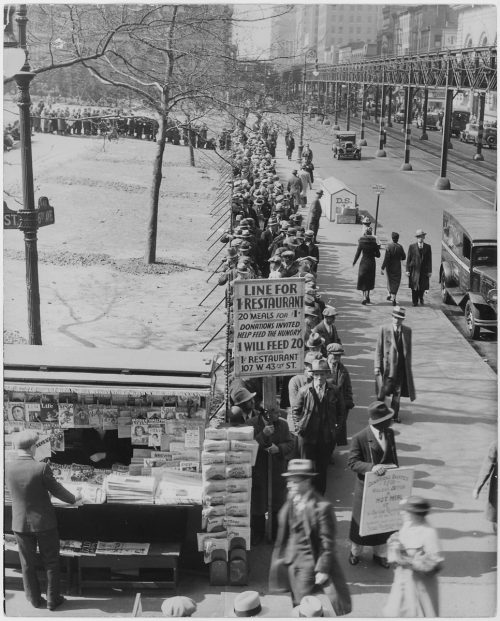The coronavirus pandemic inflicted a “swift and massive shock” that has caused the broadest collapse of the global economy since 1870 despite unprecedented government support, the World Bank said.…
“This is a deeply sobering outlook, with the crisis likely to leave long-lasting scars and pose major global challenges,” said World Bank Group Vice President for Equitable Growth, Finance and Institutions Ceyla Pazarbasioglu….
The depth of the crisis will drive 70 to 100 million people into extreme poverty.
The Depression is deep, and the pain is wide.
Yet, the NADAQ is a rocket, attempting to break out of earth’s atmosphere. As I wrote several days ago and reiterated yesterday, saying I’d follow up with greater detail today, this bubble in stocks is the most extreme euphoria ever seen. It will, however, blow when the initial burst of good news from reopening gives way to the reality of all that did not recover after reopening.
That endless lineup of headlines is arriving now.
Since COVID-19 has been rebuilding its claimed outbreaks around the nation in the news, the market has become troubled, knocking the S&P 500 and the Dow back down to that seemingly magical 61% retracement fibonacci line on the charts that really big rallies after really big crashes like to top out at.
As I mentioned yesterday, the Nasdaq has pressed on ahead in a tear. Here is how it looks relative to the rest of the economy (GDP). See if this picture looks stable to you:
And how well did that work out last time?
“Ahh,” you may say, “but this time it is only because then denominator (GDP) has crashed so hard.”
“Nay,” I say.
It is also because, in six days, the five top stocks in the NASDAQ have added half a trillion dollars to the market’s value; and, since the start of this wondrously promising year, they have added 1.6 trillion! All but one of these companies have claimed a heady position in the trillion-dollar-company club.
I’m sure that is not because their businesses have become so much more promising during 2020, earning this appreciation.
As Sven Henrich notes,
That would be a feat during any bull market during times of great growth, but in a historical recession?
So, while the Dow and the S&P got decapitated the second a new COVID-19 surge took the headlines back, the NASDAQ has continued to be a riot of irrational enthusiasm.
A growing drone of doomsayers
In June, one of the great bubble-blowing predictors of market madness joined with me (unbeknownst to him and for his own reasons of course) in calling out this madness:
Stock-market legend who called 3 financial bubbles says this one is the ‘Real McCoy,’ this is ‘crazy stuff’
Jeremy Grantham, co-founder and chief investment strategist at Boston-based money manager Grantham, Mayo, Van Otterloo & Co., [offered] up a stark warning to speculators driving the stock market to new heights amid the greatest pandemic of the past century….
“My confidence is rising quite rapidly that this is, in fact, becoming the fourth, real McCoy, bubble of my investment career. The great bubbles can go on a long time and inflict a lot of pain but at least I think we know now that we’re in one. And the chutzpah involved in having a bubble at a time of massive economic and financial uncertainty is substantial.“
Gratham painted a very dire picture of the investment landscape in the U.S., suggesting that rampant trading by out-of-work investors and speculative fervor around bankrupt companies, including car-rental company Hertz Global Holdings Inc. … reflects a market that may be the most bubblicious he’s seen in his storied career.
“It is a rally without precedence,” he told CNBC, noting that the run-up comes amid a period in which U.S. economic health is at a low point, with millions of people out of work and bankruptcies likely to continue to rise due to a slowdown in business activity and closures that have come in the aftermath of lockdowns implemented to curb the spread of the deadly COVID-19 pathogen….
Grantham is worth paying attention to due to his prescient calls over the years. He said that stocks were overvalued in 2000 and again in 2007, anticipating those market downturns.
Grantham was one of the clear-eyed people in 2000 who could look at the graph above and say it was a picture of fabulous nonsense. And this time, the graph says it is worse, and Grantham says it is worse. This time, he’s saying this stock bubble is the greatest and craziest of them all.
Grantham indicated his firm has moved to zero exposure in stocks, and he recommends others make that shift, too. And he said that nearly a month ago! Imagine what he thinks of the nonsense now.
In my last article I described three main aspects of the economy that show massive permanent business closures as a result of the first shutdown. Imagine how much worse it becomes as the knock-on effects that are continue to develop. Then imagine how much worse it becomes if any states that go back into a shutdown.
BUT THE NASDAQ KEEPS CLIMBING thanks to the fabulous five!
Second quarter 2020 came and went like a California wildfire. The economic devastation caused by the government lockdowns was swift, the destruction immense, and the damage lasting. But, nonetheless, in Q2, the major U.S. stock market indices rallied at a record pace.
The Dow booked its best quarter in 33 years. The S&P 500 posted its best performance since 1998. And the NASDAQ had its biggest increase since 1999…jumping 38.85 percent in just three months.
The economy, on the other hand, was severely scorched. Decades of debt had built up like dead wood amongst a forest understory. Then, at the worst possible time, government lockdown orders sparked a match and set it ablaze.
News of plague turns for the worse
We are now entering the phase I talked about for July where the good news from reopening starts to fade, and we get to see how much didn’t recover. Now we start to find out how much is permanently lost and, by the end of the month, we start to see the bankruptcies and foreclosures lining up like a soup line in front of the courts. Then, in August, the business dominoes start to topple because of the businesses that have already collapsed that other businesses depend on.
In this article, I’m going to start laying out the parade of facts that reveal how much did not recover during reopening. First, here was the news three weeks ago that clipped the heads off the Dow and S&P:
Coronvirus cases rise in at least 9 U.S. states, while Fed’s Powell tells Congress unemployment benefits should be extended. U.S. stocks slumped in the final hour of trade Wednesday to end three days of gains, as investors monitored signs of a revival of the coronavirus pandemic in some U.S. states and China, while still hoping for a quick economic recovery as business activity resumes….
Investors monitored the trajectory of new coronavirus cases, as business activity resumes after lockdowns, along with a fresh outbreak in China, but the focus remains on the path to economic recovery, amid some progress in developing therapeutic drugs and vaccines against COVID-19….
Meanwhile, Arizona, Florida, Oklahoma, Oregon and Texas all saw record increases in new cases on Tuesday, while hospitalizations in Texas, Nevada and Florida hit records, according to Reuters….
China canceled flights to and from Beijing, restricted movement of people, and closed schools in the capital city, after 137 new cases were reported in recent days….
“If COVID-19 were to get so bad this fall that the economy had to totally shut down, stocks would fall and fall hard. But right now, even with a surge, the general consensus is that the economy won’t completely shut down again,” said James Meyer, chief investment officer at Tower Bridge Advisors….
We all know now how that return of the COVID story went. The news just continued to grow worse. Whether the cases of disease are rightly reported or not, this is the news that has dominated, and it is the news governors will certainly be responding to as they consider whether or not to remain open for business. Some of them have already begun winding back toward closure.
So, good luck with the idea that the economy will not shut down again! It’s already doing it in statewide moves. Trump may rail against it at a national level, but his own health advisors have been saying we need to move back in the direction of closure, and numerous states have shown they are free to ignore Trump on this issue, which they did when they chose the last lockdown against his express will.
So, that’s a heck of a thing to be banking on!
“Atlanta Mayor Set To Reimpose Lockdown As Cases Surge, Defying Gov Kemp, Trump“
And good luck with the economy not remaining well below where it was in January of this year (already not a good place) for a minimum of two years to come (probably more). Good luck with the arrival of end of the reopening bump in good-news statistics not taking out the stock market’s drug-addled euphoria later this summer if COVID-19’s rising case claims don’t do the job first.
(Note I say claims because a few people in the medical profession have contacted me to tell me they are instructed by the CDC to report all respiratory deaths as COVID-19 unless they are known with certainty to be something else. Yesterday, a reader here told me he heard Ron Paul claim that Texas is now reporting people who merely come into contact with COVID-19 as actual COVID-19 cases. See: “Ron Paul: Is the Texas COVID ‘Spike’ Fake News?” I keep hearing various reasons to question the numbers that are coming through. Still, as I said before, perception is reality in terms of how this story hurts the economy because politicians are acting on it and so are hundreds of millions of customers.)
Failure of the Fed is already being sensed
The stock bubble is already looking ready to burst. The Robinhood crowd, where the reigning self-proclaimed champion Dave Portnoy has proclaimed “stocks rise forever,” may be in for some sticker a shock when prices crash:
The first crack appears in bulls’ thesis that the stock market will rise no matter what.
Money printing by the Federal Reserve has propelled stocks for more than a decade. But that effect may soon wear off….
Until recently, the Fed has been unreasonably intransigent in that it will continue money printing even if the economy became strong and there was no need for it…. When the Fed announced it will buy individual bonds, the stock market loved it….
Fed Chairman Jerome Powell is a smart man. The way he came across in his press conference after the FOMC policy decision last week was troubling in that he was going to do whatever it took without regard to consequences and limits. Why would a smart man like Powell show such intransigence?…
Powell is being clever in exhibiting intransigence because he wants everybody to believe that the Fed is all in and there are no limits to what the Fed can do….
[However, looking deeper into Powell’s words:]
“We’re not actually increasing the dollar volume of things we’re buying. We’re just shifting away from ETFs toward this other form of index….”
The crack in the bulls’ thesis is that contrary to their belief, the Fed is becoming measured and may have difficulty expanding its balance sheet beyond $10 trillion. In plain English, unlimited money printing is highly unlikely…..
Why is Powell talking big but then showing some signs of not going there? Maybe he’s offering empty reassurance as the Fed actually backs off on its monetary support of the market’s rise. He might talk big and back away if he knows the Fed is at the point where the distortions it blows into being are worse than what it seeks to cure.
Right now, the Fed’s financial money-printing in support of the market looks like the red line below:
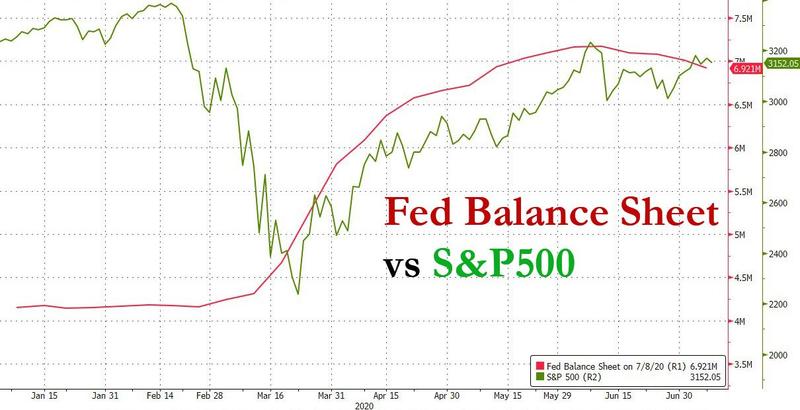
The Fed knows it has pumped the stock market into the highest bubble in history, and it is trying to taper that because the risk gets worse the bigger the bubble gets. However, economic damage that is still building will likely press it back to more money creation. In the meantime, we know now from past experience, not just from my saying it would prove to be so, that the Fed cannot taper its balance sheet without crashing the market it has rigged up. We see in the graph the S&P has already responded by settling back down (same for the Dow as shown yesterday), and so the market is tipping.
With no further adieu, here is the rapidly approaching lineup of bad news the market is ignoring. Here is the bad news that is now relentlessly drumming louder and louder until it will become a deafening roar the market cannot ignore. (And the Fed is backing down right as the news arrives, though its arrival will push the Fed back to running the money pumps, which may, if that happens, buy the market a little more time … like until September; but right now, I’d say August is looking good for the start of a crash.)
The drumbeats of the Epocalypse
A parade of headlines has been marching into town during the past couple of weeks, telling a story of death and destruction due to a plague hitting a world burdened under a crushing load of debt, papered over with optimistic accounting gimmicks that emit a sweet stink something like rose water poured over decaying meat.
How can anyone not hear the following noisy parade coming?
The results were predictable to everyone but the experts. Supply chain disruptions followed by retail disruptions, followed by declining sales, followed by disappearing cash flow, followed by layoffs, followed by business closures, followed by shrinking tax receipts, followed by unserviceable public and private debt, followed by mass bankruptcies, followed by riots, followed by full societal breakdown.
Now, the parade of facts has arrived.
Consumer spending fails to recover:
We can see from Chase that consumer spending via credit card improved during reopening, but now appears to have flatlined about 10% lower than it was last year:
Airline recovery take-off sputtered back toward ground:
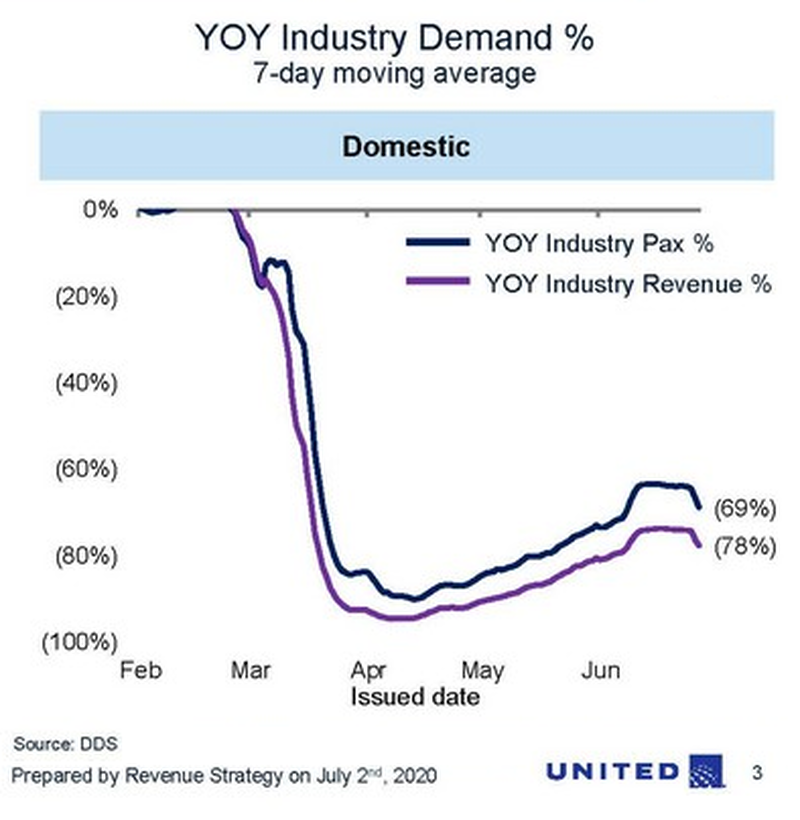
Wolf Street
Flights are still down about 70% and that is at reduced ticket prices (as evidenced by revenue falling more percentage-wise than than number of passengers booked). International flights are, of course, even more pathetic:
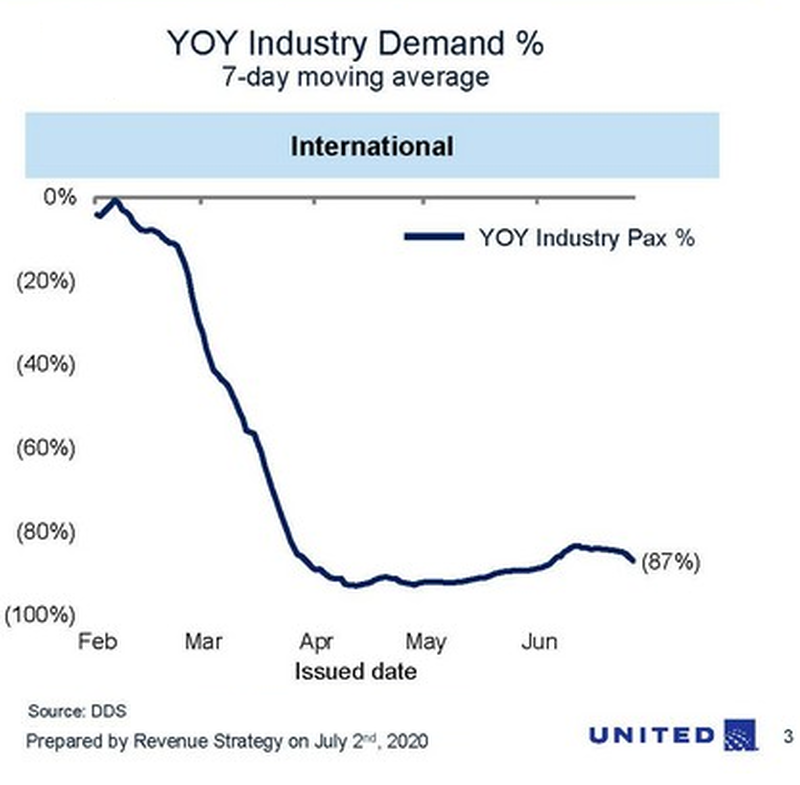
That’s as far off the ground as they got. Looks like a plane wreck off the end of the runway to me.
United Airlines announced that 36,000 employees in the US, or 45% of its US workforce, could face “involuntary furloughs” on or after October 1. That’s the day after the restrictions attached to the $25 billion in payroll aid under the CARES act expire….
The “involuntary furloughs” would include up to 15,000 flight attendants, 11,000 customer service and gate agents, 5,500 maintenance workers, and 2,250 pilots. Another 1,300 management and support staff will be laid off on October 1
Airbus To Cut 15,000 Jobs As No Recovery Expected Until 2023
Airbnb CEO and co-founder Brian Chesky said the global travel and tourism industry might never fully recover from the coronavirus pandemic.
As the great urban evacuation begins in America, rent in Manhattan has already fallen 6.6% (during reopening):
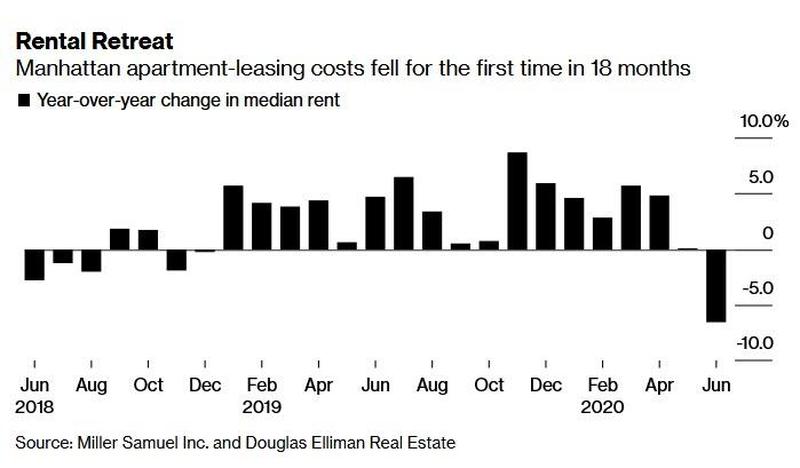
That’s the first decline in eighteen months and the largest drop since 2011. No one wants to live in virus central. Or it’s just a case of “So, who has money to pay rent?”
US home prices now at risk just like Manhattan rent:
Despite relatively steady home price appreciation in May, the U.S. housing market is on the precipice of an extended price slump, according to a CoreLogic report released Tuesday. The housing data provider’s May Home Price Index and HPI Forecast report predicts a year-over-year home price decrease of 6.6% by May 2021.
How serious is the housing peril?
Nearly Half Of Americans Consider Selling Home As COVID Crushes Finances
As the virus pandemic has metastasized into an economic downturn … new research offers a glimpse into struggling households…. Out of the 2,000 American homeowners polled, over half (52%) of respondents say they’re routinely worried about making future mortgage payments and nearly half (47%) considered selling their home because of the inability to service mortgage payments.
Oldest retailer in US files Chapter 11 bankruptcy:
People who work from home don’t need to dress up for work.
This new COVID normal of (in)formal meetings seems to have been the last nail in the coffin of America’s most iconic menswear retailers as Brooks Brothers has just filed for bankruptcy (just weeks after Men’s Wearhouse owner Tailored Brands considered the same).
A tidal wave of bankruptcies is coming:
Experts foresee so many filings in the coming months that the courts could struggle to salvage the businesses that are worth saving.
Edward I. Altman, the creator of the Z score, a widely used method of predicting business failures, estimated that this year will easily set a record for so-called mega bankruptcies — filings by companies with $1 billion or more in debt. And he expects the number of merely large bankruptcies — at least $100 million — to challenge the record set the year after the 2008 economic crisis.
Even a meaningful rebound in economic activity over the coming months won’t stop it, said Mr. Altman, the Max L. Heine professor of finance, emeritus, at New York University’s Stern School of Business. “The really hurting companies are too far gone to be saved,” he said.
It’s damage already done.
Businesses that had been reopening are slowing back down:
Hours worked at more than 44,000 small businesses, whose employee hours are managed by Homebase, fell in 25 states in the week ending June 28. That included a more than 7% decline in Arizona and a more than 5% drop in Texas, where new outbreaks forced governors to renege on aggressive efforts to reopen the economy….
Goldman Sachs analysts estimated that states accounting for over half the U.S. population had now paused or partially reversed their reopening plans, with limits reimposed most often on bars, restaurants and the size of gatherings.
Big Apple may deliver less byte for the buck:
Sources familiar with Apple’s supply chain partners said suppliers ‘are less optimistic about shipments’ for the new 5G iPhone…. sources said 2020 5G iPhone 12 shipments could be halved, from 30-40 million to just 15-20 million.
That’s OK. Sales of primary products are not necessary in order to justify skyrocketing stock prices as we soar mindlessly toward the realm where shell corporations eventually trade at a trillion dollars in market cap. Life’s good.
Chicago Purchase Manager’s Index fails to rise as much as expected:
In conclusion
I’m going to sum it up by letting a rather big authority confirm all I’ve been saying about this recession being a great depression before it even began: (Though they completely failed — again — to see economic collapse coming, the experts eventually caught up with me.)
UCLA Anderson Forecast senior economist David the UCLA Anderson Forecast revised its outlook for the U.S. economy downward because of the expected impact of COVID-19, which was then still being referred to as an epidemic. Two weeks later, as the economy began shutting down because of the pandemic, the Forecast released the first revision in its 68-year history to assert that the U.S. economy was already in recession.
Now, in its second quarterly forecast of 2020, the Forecast team states that the global health crisis has “morphed into a Depression-like crisis” and that it does not expect the national economy to return to its 2019 fourth-quarter peak until 2023.… U.S. employment will not recover until “well past 2022…. “Simply put, despite the Paycheck Protection Program, too many small businesses will fail and millions of jobs in restaurants and personal service firms will disappear in the short run. We believe that even with the availability of a vaccine, it will take time for consumers to return to normal.…”
The forecast notes that while the economy seems to have hit bottom, it will be a while before GDP and employment levels reach fourth-quarter 2019 levels, as the huge debt buildup in both the public and private sectors dampen output….
For too many workers, the recession will linger on well past the official end date of the depression.
Thank you.

